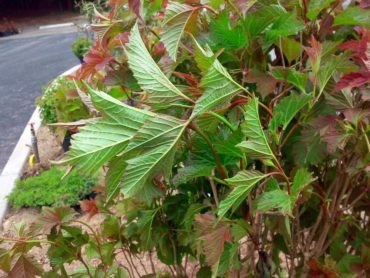
Wilting leaves. Sooner or later, everyone who gardens — from just a single house plant to a grand vegetable patch — will encounter a droopy plant. The remedy is a universally known response: Water the plant. Pour some water on it or set up a sprinkler. Just get water on it somehow. Everyone knows that, right?
Watering wilting plants is a reflexive response found from expert gardeners to the unfortunately brown-thumbed. There are some things an experienced gardener knows that may surprise others, however. Not every wilting plant needs to be watered. Those fancy soil-moisture probes may not be money well spent. And sometimes watering in the rain is not crazy.
Plants wilt when they lack enough internal water to “inflate” like a balloon. Internal water escapes the plant usually by evaporating into the air through the leaves. This lost water must be replaced or the plant will start to droop. Typically, roots absorb water from the soil to replace what has been lost.
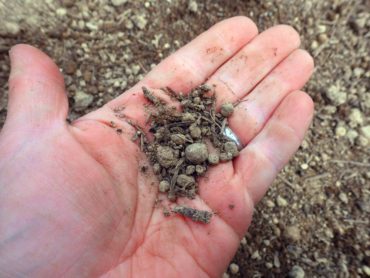
But first things first. How can the amount of water in the soil be determined? Forget about fancy soil-moisture meters. They have their place but for most gardeners, a technique that has been around since the dawn of farming works best: sticking a finger in the ground.
More precisely, take a marble-size bit of soil from the ground 1-2 inches deep and do a “ball test.” Squeeze that bit of soil into a ball in the palm of your hand. Then release your grip and examine the soil. The better the soil remains “balled” up, the more moisture is in that soil. If the ball crumbles quickly, the soil may be too dry for the plant.
One note about using soil color as a moisture indicator: It is unreliable. Soil darkens when wetted. We often use that color change as a gauge of when to water but it can fool you sometimes in a couple ways.
First, soil will dry out in the top few millimeters on a sunny day even when there is plenty of water below. Thus an apparently desert condition can be deceiving unless you actually dig below the surface and do a ball test. Second, soils with lots of compost or other well-rotted organic matter can appear dark and “wet” while being too dry for plant growth. A ball test will reveal the true dry nature of such soils.
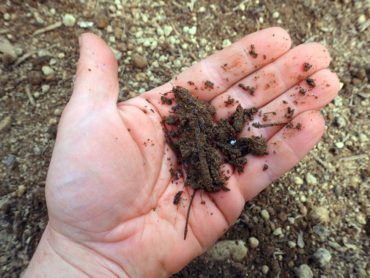
The most common cause of wilting plants is inadequate soil water. But this is not always the case. What if something prevents a plant from absorbing water present in the soil? Several things can cause a plant to wilt even with plenty of water in the ground.
With the ball test available in the gardener’s mental toolbox, a wilting plant can be properly assessed. Step one when finding a wilting plant is to do a ball test on the soil under the plant. If the soil is dry, it probably needs water. If the soil is wet, however, the wilting likely has a different cause.
In the heat of summer, one phenomenon causing wilting in moist soil is “incipient wilt.” Some plants wilt very easily in the hot sun because they are losing water faster than their roots can absorb it.
Japanese hydrangea (Hydrangea macrophylla) is a good example. This is just a temporary wilt that disappears in the evening or even just when a cloud passes over. Damage rarely results and the best thing to do is not panic and resist the urge to water.
Root death is a very common cause of wilting. One of the roots’ functions is to absorb water for the above-ground portion of a plant. Death of roots means a plant’s ability to acquire adequate water is impaired. Lose enough roots and a plant will wilt and possibly die from lack of water despite the soil being moist. Several things can cause roots to die.
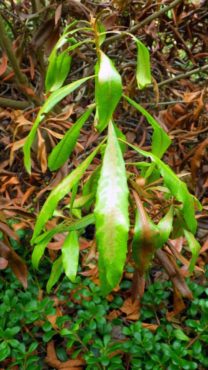 Root-rot diseases are common in the West Sound, unfortunately, and are perhaps the leading cause of root death in our area. The frequent rain and mild temperatures encourage several kinds of root-disease fungi. It is especially important that root-diseased plants are not watered unless the soil is getting dry, since the excess water may actually make the disease worse. Frequently, all that is needed to stop root disease is watering less often.
Root-rot diseases are common in the West Sound, unfortunately, and are perhaps the leading cause of root death in our area. The frequent rain and mild temperatures encourage several kinds of root-disease fungi. It is especially important that root-diseased plants are not watered unless the soil is getting dry, since the excess water may actually make the disease worse. Frequently, all that is needed to stop root disease is watering less often.
Speaking of watering wilted plants — too much water may also cause wilting. Like people, plants need oxygen to survive. Roots need to “breathe” and being submerged too long is similar to drowning.
This is common when plants are placed in naturally wet areas or if drainage funnels water over the plant’s root zone. The saturated soils are low in oxygen and the roots die, hurting the plant’s ability to absorb water. Wilting ensues. This is best avoided by either improving drainage or selecting plants that can tolerate continually wet ground.
A third, less common cause of root death is freezing temperatures. Fortunately, this is unusual in the West Sound but can happen, especially in containerized plants. Roots are generally the least freeze-tolerant part of plants and are more susceptible to cold damage than aboveground parts. Plants in pots have their roots more exposed during the winter and are more likely to suffer root death from freezing temperatures.
Freeze damage to roots is not usually obvious until early spring, when the potted plant tries to grow. The plant will appear OK through the winter but when new shoots try to grow, they need water yet cannot get it because of dead roots. Container plants that suddenly wilt in the spring probably suffer from cold-damaged roots.
Damage to aboveground parts of plants can also cause wilting. Stems and trunks transport water from the roots to the leaves and significant stem damage can cause wilting. Things that cause this kind of damage are broken branches, shrubs hit by weed eaters, bark rubbed off by deer, and bark-eating squirrels, to name a few.
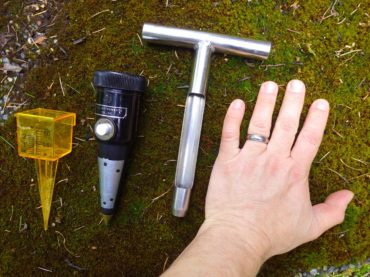
Certain diseases called “vascular wilts” also can cause wilting by plugging up the water-transporting portion of plants. Examples include Verticillium wilt common on smoke tree, dahlias and Japanese maple; and Dutch elm disease, responsible for major decline of elm numbers in the United States.
One sign that a plant may have a wilt disease is the appearance of drooping, first in one or a few branches rather than the entire plant. Eventually the disease spreads enough to wilt and kill the whole plant. With many wilt diseases, wood around the border between wilted and unwilted parts of the stem may show brown streaks under the bark.
Watering plants that have wilt disease will not help. Usually, there is not much to be done besides pruning out wilting branches back to healthy wood.
For most plants in a garden, watering is only needed when the soil begins to dry out. For established ornamental plants, a brief dry period can be good for them and stave off root disease. Your vegetables may need more consistent soil moisture to produce a good crop, however. Monitor the soil daily. If you can squeeze water out of a hand full of soil, no watering is needed.
If you decide to water, try to water in the morning. The cooler temperatures will cause less loss of irrigation water to evaporation than in the hot afternoon. Additionally, morning watering will give plenty of time for excess water to drain off. Watering in the evening may lead to wet soils sitting over night, which may encourage root diseases.
Gardeners often have a love-hate relationship with rain. It may keep them indoors sometimes but other times, it is welcome for the watering it brings. Conventional wisdom is that watering is not needed in the rain. That is almost always true but sometimes it is OK or even advantageous.
In the spring in the West Sound, large trees can suck the soil dry with the warming temperatures and longer days. Often, rains will not be enough to replenish moisture to these soils and garden plants may suffer. This is one reason why gardening under big trees can be difficult.
Watering plants under large trees in the rain can be good if trying to remedy dry soil. Check the local weather forecast first. Unless a major rainstorm is predicted, go ahead and water. One additional perk of watering on a slightly rainy day: Evaporation will be minimal so little irrigation water will be wasted.
Watering plants when they do not need it is also wasteful. Not every wilted plant needs to be watered so check to see if the soil is actually dry first. You may discover disease, overwatering or other problems are to blame and can correctly remedy them.




























Comments